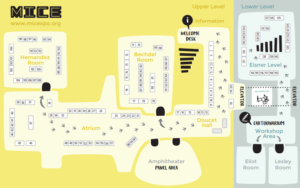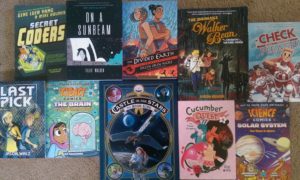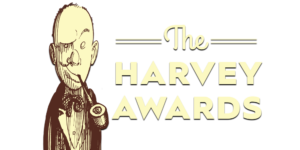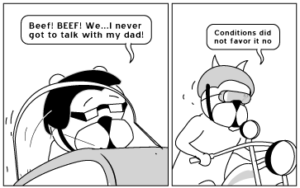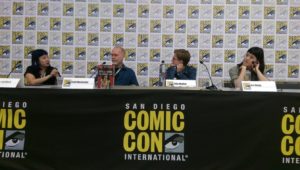
[Editor’s note: As in the past, these panel recaps are based on notes typed during the session; all discussion is the nearest possible paraphrase, except for direct quotes which will be italicized.]
What do you get when you combine a comics festival co-founder, a former competitive figure skater, a composer/computer scientist, and a manager of teen library services? A wide-ranging discussion on the nature of YA books, on account of those four people are, respectively, Jen Wang, Tillie Walden, Scott Westerfeld, and moderator Candice Mack.
With a small panel, Mack was able to address most questions to each of the panelists, and had them start out with a quick description of their latest or next graphic novels; Walden and Wang spoke of Spinning and The Prince And The Dressmaker, while Westerfeld mentioned his upcoming sequel to last year’s The Spill Zone, titled The Broken Vow (both illustrated by Alex Puvilland). For three such different books, certain common themes were described by the creators. We’ll come back to that idea in a bit.
Given the very different stories, Mack asked about the focus that each chose for their stories, and the process of coming to that series of decisions. Walden very nearly denied that such a process exists, indicating that for her the important thing is an intuition about the story she wants to tell; specifically, the sustained effort of making a graphic novel is such that she needs to find something to hold her interest for the whole time it will take me to make the goddamn book.
With reference to the critically and popularly acclaimed Spinning, Walden declared that one day she woke up and thought Shit I need to make a comic for class. I was an ice skater, I can make a comic about that! The story she could tell fit that particular need rather than being one she was burning to tell, despite the topic being that which had dominated her life more than anything else for a dozen years.
Westerfeld found his inspiration in place: the Spill Zone books take place in a post-low grade apocalyptic Poughkeepsie, and he’d learned about the history of the town while attending Vassar. Despite being very wealthy for a period of town and not falling into the traditional Rust Belt, Poughkeepsie is a post-industrial town that’s fallen from its glories. In this case, it was the center of the very lucrative trade in ice for New York City, until the invention of refrigeration dealt a blow in the early 20th century, from which the city has not yet recovered. The nostalgia that’s bred into the city and its residents appealed to him, as did his stint as an urban explorer, making his way through once grand/now abandoned buildings, filled with mysterious traces of the people that lived there. It’s basically the plot of The Spill Zone, minus the otherworldly horrors that killed everybody.
Wang said she had a couple of different ideas floating, specifically an idea for a story about sewing, or possibly someone whose superpower was sewing. The transformation quality to making clothes captured her imagination (despite claiming to have no skills in the arts), which provided a handy metaphor for the transformation that her main characters go through.
We’ll continue with Wang’s answer in a moment, but remember that bit about all three stories having common themes? Transformation was a key one, whether it’s the transformation of gender, the transformation of self via single-minded dedication (coupled with the transformation to somebody who doesn’t do that anymore¹), or the sudden transformation of a city and its unlucky inhabitants. I’d remark later that I couldn’t think of three more different books that I’d read in the past year, but they all had that piece in common, along with nostalgia and finding identity. At the very least, Westerfeld would later argue, the finding identity part is the ur-theme of YA.
Back to Wang’s answer, she also cited a desire to do something in the Disney mold, meaning the transformation would be more personal than superheroic, and provide the basis for (hopefully) a fun, light story. The Disney angle led to the setting (post Industrial Revolution, pre-modern), a time of change (horse carriages and department stores, mass produced sewing machines, and as Westerfeld observed, an aristocracy that’s moving from old fashioned to irrelevant).
That led to a discussion on their main characters, and the degree to which they were designed to be directly familiar to YA readers. Westerfeld had a story with a protagonist that could have been any age, but bringing her down to late teens/early 20s and making her suddenly responsible for a younger sibling let him explore another dimension of leaving youth. As he noted, adulthood gets thrust on younger people depending on economics and place; Poughkeepsie’s already a place of melancholy/nostalgia thrust on residents at a young age, and the disaster added another layer of nostalgia not for the rich past, but for the time just a bit ago before the city was swallowed by monsters and extradimensional horrors.
Walden, by contrast, never set out to do YA, but wound up there by virtue of her experience. When I was 17, my characters were 17 year old girls; publishers, however, do care about who stories are pitched to, and she realized how much she enjoyed working in the category of teens and children, coming of age, but ending up there was accidental. Wang also fell into YA by accident, where TPATD‘s characters were initially adults. Aging them down to teens allowed a story of big feelings, discovering things for the first time. Her only concern was Is it weird that the prince is expected to get married really young?” and the others agreed that it served to show how quickly life changes at that age.
Westerfeld pointed out that’s one of the key aspects of teendom is everything is SO BIG: a bad day when you’re a teenager is the end of the world, a good day is the best thing ever. Walden emphasized the speed, a time of life when big things happen one right after another; Westerfeld added some historical context to point out that you used to co from childhood straight to adulthood, heading into the factory or mines at 10, 12, maybe 15. The transitional stage between childhood and adulthood is a recent invention: The word teenager is only from 1948. We’re still working it out as a culture.
Less philosophical concerns rounded out the session. Mack wondered about work habits, and all three discussed the importance of routine. Westerfeld has the act of writing down to muscle memory, in that he writes every morning in the same space, in the same chair, at the same time, after the same breakfast. Walden’s had a lot of airport lounges and hotel desks in her writing experience over the past year, but at home in LA she’s found a co-working space to be a help: it’s got A/C in a warm climate, and you can leave your stuff when you go to lunch, as opposed to working in the local coffee shop.
Wang offered the routine was more present in her drawing time than her writing time, which prompted Westerfeld (who doesn’t draw) to ask if the drawing imposes consistency on their work — a predictable amount of output (Wang: by the time I draw, I know where the story is supposed to go and can steer it), the opportunity to fix writing in the drawing (Wang and Walden: Oh, yeah). Walden described drawing as the reward — she says she can’t write dialogue, but drawing speech bubbles makes her hear the words that characters will use. Westerfeld found all of this to be NUTS, but described a somewhat similar back-and-forth with Puvilland (a non-native English speaker, he approaches the story with different timing or beats that Westerfeld scripts, leading to new ways of looking at the story and what it needs to accomplish).
Mack asked each what the strangest thing they’d ever done for research was; Wang learned to play World Of Warcraft when adapting Cory Doctorow’s In Real Life to a graphic novel. Walden learned to drive stick because she had a character that did and had no idea how to draw their hands. Westerfeld didn’t have an answer himself, but mentioned that Holly Black once had herself thrown in a car trunk and driven around to determine what it was like; I’ve never done anything like that, so I guess I’m not that into research, he concluded.
A brief Q&A asked about desire to get into animation (all three: not really), and if there was a particular YA work that had an impact on their work. Westerfeld said that YA category didn’t really exist when he was grown up, but he gravitated to the sci-fi section; his most influential books were Dune and Charlotte’s Web. Walden loved Roald Dahl until he became problematic: My mom was “Tillie, he’s anti-semitic and we’re Jewish” and I’m WHAT. And Wang found her prime YA years more occupied with manga and anime, but at and earlier stage devoured Brian Jacques’s Redwall series.
None of them could say that YA had an influence on their work, but meaning the ur-themes of transformation and finding yourself were less inculcated in them, and more self-developed alongside the YA tradition. I’m going to bet in another 20 years, some future YA authors will have answers to the same question that much directly credit Wang, Walden, and Westerfeld.
_______________
¹ Which led to a hilarious exchange between Westerfeld and Walden:
SW: What makes Spinning really sad is walking away from something you committed so much to.
TW: I KNOW.
SW: You can see it from the beginning, and it makes everything that’s brutal about getting up at 4:00am not worth it. I, Tonya has a happier ending!
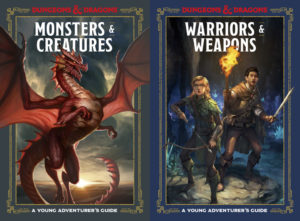
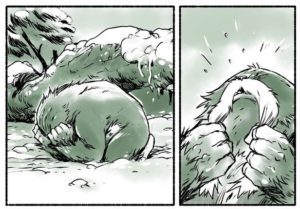
![Ryan North is the Big Cow of [web]comics.](http://fleen.com/wp-content/uploads/2018/11/CowRatio-300x116.jpg)
